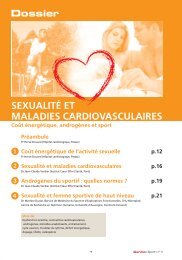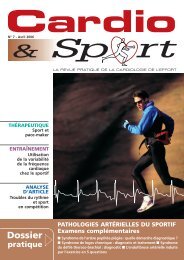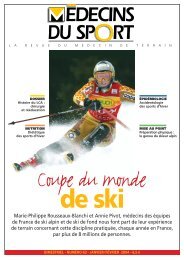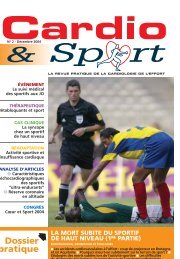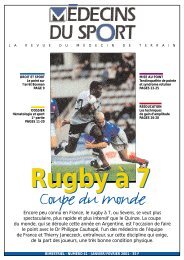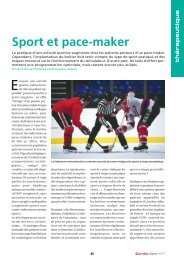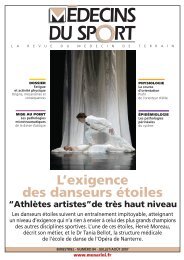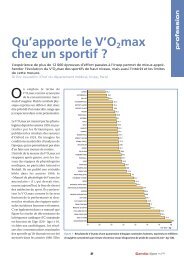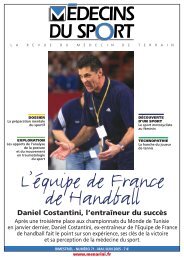Cardio et Sport - msport.net
Cardio et Sport - msport.net
Cardio et Sport - msport.net
- No tags were found...
You also want an ePaper? Increase the reach of your titles
YUMPU automatically turns print PDFs into web optimized ePapers that Google loves.
d’une ischémie myocardique symptomatique(5). Il est donc probablequ’il existe, chez le suj<strong>et</strong> entraîné, uneff<strong>et</strong> direct des bêta-endorphines surla symptomatologie clinique.Eff<strong>et</strong> de l’entraînementsur l’ischémie myocardiqueL’entraînement physique diminue lafréquence cardiaque <strong>et</strong> améliore laperformance des coronariens (1). Lesadaptations vasculaires peuvent êtremacrovasculaires (dilatation, collatéralité)<strong>et</strong>/ou microvasculaires (diminutionde la dysfonction endothéliale,angiogenèses capillaire <strong>et</strong> artériolaire).● L’entraînement physique augmentela collatéralité coronaire chez le suj<strong>et</strong>ischémique.C<strong>et</strong>te hypothèse a été démontrée chezl’animal de laboratoire <strong>et</strong> plus difficilementchez l’homme. Cliniquement, onsait que la pratique de 2 épreuves d’effortà 10 minutes d’intervalle m<strong>et</strong> en évidence,lors de la deuxième épreuve, uneaugmentation du seuil d’apparition del’ischémie, pouvant signifier l’ouvertured’une circulation collatérale (6).● L’entraînement améliore la dysfonctionendothéliale chez le coronarien(7-9).Ainsi, après un entraînement de4 semaines, l’injection d’acétylcholine(action sur les vaisseaux conductifs)améliore la vasoconstriction <strong>et</strong> l’adénosine(action sur les vaisseaux résistifs)améliore la réserve coronaire.● D’autres eff<strong>et</strong>s positifs ont été misen évidence.Un eff<strong>et</strong> sur l’angiogenèse capillairechez l’animal de laboratoire (10) <strong>et</strong> uneff<strong>et</strong> sur la viscosité sanguine, qui augmentemoins lors de l’exercice aiguchez le suj<strong>et</strong> entraîné.● Quelle durée d’entraînement estnécessaire pour améliorer le seuilischémique des coronariens ?Quelques semaines d’entraînementsuffisent pour améliorer la fonctionendothéliale. L’amélioration des angiogenèsescapillaire <strong>et</strong> artériolairedemanderait plusieurs mois d’entraînement.L’apparition d’une véritablecirculation collatérale à l’effort seraitle fruit de plusieurs années d’entraînement(11).> En conclusionL’entraînement physique augmente leseuil angineux des coronariens <strong>et</strong> améliorela perfusion myocardique. CesDossiereff<strong>et</strong>s bénéfiques sont recherchés enréadaptation.Toutefois, le fait que les sportifs coronariensne ressentent pas ou peu dedouleur ischémique, tout en réalisantdes efforts importants, peut “camoufler”une authentique coronaropathie<strong>et</strong> les exposer à un risque d’accidentaigu révélant une pathologie qu’ilsignoraient. C’est, par exemple, le casd’un des suj<strong>et</strong>s de notre série qui a présentéun arrêt cardiaque inaugural. Lamoindre douleur thoracique survenantà l’effort chez un sportif doit êtreprise en grande considération !La surveillance de sportifs qui présententdes facteurs de risque doitcomprendre une épreuve d’effortpour rechercher une ischémie. Lapositivité d’une épreuve d’effort, quim<strong>et</strong> en évidence une pathologie coronairechez un sportif, implique desactions de prévention, comme cheztout coronarien, associées à d’éventuelsconseils de modération sur lesobjectifs sportifs.La négativité d’une épreuve d’effortchez un suj<strong>et</strong> entraîné est de bon pronostic,mais n’exclut pas totalement laprésence d’une maladie coronaire <strong>et</strong>,donc, n’exclut pas le risque d’une rupturede plaque instable. Mais on nepeut pas tout prévoir ! ■DossierBibliographie1. Poy<strong>et</strong> R. Les manifestations de l’ischémie myocardique sontelles différentes chez les coronariens sportifs ? Thèse médecine,2003, Lyon.2. Ehsani AA, Heath GW, Hagberg JM <strong>et</strong> al. Effects of 12months of intense exercise training on ischemic ST-segmentdepression in patients with coronary artery disease. Circulation1981 ; 64 : 1116-24.3. Todd IC, Bradman M. Effects of daily high-intensity exerciseon myocardial perfusion in angina pectoris. Am J <strong>Cardio</strong>l 1991;68 : 1593-9.4. Tendzegolskis Z, Viru A, Orlova E. Exercise-induced changesof endorphin contents in hypothalamus, hypophysis, adrenalsand blood plasma. Int J <strong>Sport</strong>s Med 1991 ; 12 : 495-7.5. Goldfarb AH, Hatfield BD, Potts J, Armstrong D. B<strong>et</strong>a-endorphintime course response to intensity of exercise: effect oftraining status. Int J <strong>Sport</strong>s Med 1991 ; 12 : 264-8.6. Hikita H, Etsuda H, Takase B <strong>et</strong> al. Extend of ischemic stimulusand plasma b<strong>et</strong>a-endorphin level in silent ischemia. AmHeart J 1998 ; 135 : 813-8.7. Kay IP, Kittelson JM, Stewart RA. Relationship b<strong>et</strong>ween durationand intensity of first exercise and ‘warm-up’ in ischaemicheart disease. Heart 2000 ; 83 : 17-21.8. Hambrecht R, Adams V, Erbs S <strong>et</strong> al. Regular physical activityimproves endothelial function in patients with coronary arterydisease by increasing phosphorylation of endothelial nitricoxide synthase. Circulation 2003 ; 107 : 3152-8.9. Hambrecht RJ, Wolf A, Gielen S. Effect of exercise on coronaryendothelial function on patients with coronary arterydisease. N Engl J Med 2000 ; 342 : 454-60.10. White FC, Bloor CM, McKirnan MD. Exercise training inswine promotes growth of arteriolar bed and capillary angiogenesisin heart. Heart J Appl Physiol 1998 ; 85 : 1160-8.11. Gielen S, Shiler G, Hambrecht R. Exercise training in coronary arterydisease and coronary vasomotion. Circulation 2001 ; 103 : E1-6.17 <strong>Cardio</strong>&<strong>Sport</strong> • n°14




